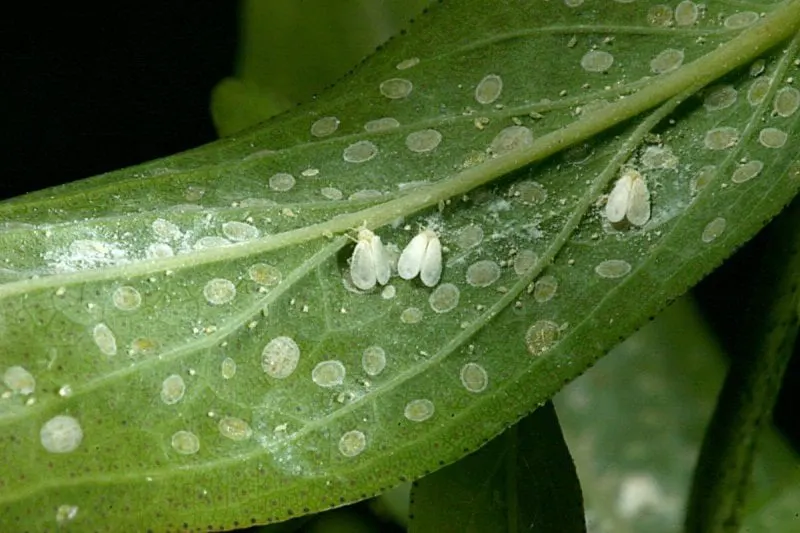Natural GMO: Whiteflies stole a gene from plants millions of years ago that can protect them from pesticides
Natural GMO: Whiteflies stole a gene from plants millions of years ago that can protect them from pesticides


Pale, squishy, and smaller than a sesame seed, these sap-sucking bugs terrorize more than 600 plant species, infecting them with deadly viruses and smearing their leaves with sweet, sticky liquids that encourage the growth of molds.
…
Against such an enemy, plants deploy poisons powerful enough to stunt insect growth or bring about the bugs’ untimely demise. But whiteflies (which aren’t flies, but cousins of aphids) have found a work-around for this obstacle, too, through thievery.
To protect themselves against toxins called phenolic glycosides, a common botanical defense, whiteflies imported a stolen good: a gene that encodes a kind of antidote, likely pilfered from an ancient poisonous plant, according to a study published [March 25] in Cell. The plant had probably created the chemical cure to protect its own tissues.
It’s certainly possible that plant DNA, adrift in the whitefly’s digestive tract, somehow meandered its way over to a reproductive cell. But [chemical ecologist Ted] Turlings said he and his colleagues think the whitefly had help from a virus with privileged access to parts of the insect’s body… Perhaps what the researchers found is not a direct plant-to-insect dispatch, but a protracted relay that could have taken place over many years—a molecular drug trade, with microbes acting as the mules.
Read the original post

 | Videos | More... |

Video: Nuclear energy will destroy us? Global warming is an existential threat? Chemicals are massacring bees? Donate to the Green Industrial Complex!
 | Bees & Pollinators | More... |

GLP podcast: Science journalism is a mess. Here’s how to fix it

Mosquito massacre: Can we safely tackle malaria with a CRISPR gene drive?

Are we facing an ‘Insect Apocalypse’ caused by ‘intensive, industrial’ farming and agricultural chemicals? The media say yes; Science says ‘no’
 | Infographics | More... |

Infographic: Global regulatory and health research agencies on whether glyphosate causes cancer
 | GMO FAQs | More... |

Why is there controversy over GMO foods but not GMO drugs?

How are GMOs labeled around the world?

How does genetic engineering differ from conventional breeding?
 | GLP Profiles | More... |

Alex Jones: Right-wing conspiracy theorist stokes fear of GMOs, pesticides to sell ‘health supplements’




 Trust issues: What happens when therapists use ChatGPT?
Trust issues: What happens when therapists use ChatGPT? Fighting deforestation with CO2: Biotechnology breakthrough creates sustainable palm oil alternative for cosmetics
Fighting deforestation with CO2: Biotechnology breakthrough creates sustainable palm oil alternative for cosmetics California, Washington, Oregon forge immunization alliance to safeguard vaccine access against federal undermining
California, Washington, Oregon forge immunization alliance to safeguard vaccine access against federal undermining Viewpoint — Fact checking MAHA mythmakers: How wellness influencers and RFK, Jr. undermine American science and health
Viewpoint — Fact checking MAHA mythmakers: How wellness influencers and RFK, Jr. undermine American science and health 30-year-old tomato line shows genetic resistance to devastating virus
30-year-old tomato line shows genetic resistance to devastating virus Viewpoint: Video — Big Solar is gobbling up productive agricultural land and hurting farmers yet providing little energy or sustainabilty gains
Viewpoint: Video — Big Solar is gobbling up productive agricultural land and hurting farmers yet providing little energy or sustainabilty gains The free-range chicken dilemma: Better for birds, but with substantial costs
The free-range chicken dilemma: Better for birds, but with substantial costs ‘You have to treat the brain first’: Rethinking chronic pain with Sanjay Gupta
‘You have to treat the brain first’: Rethinking chronic pain with Sanjay Gupta
